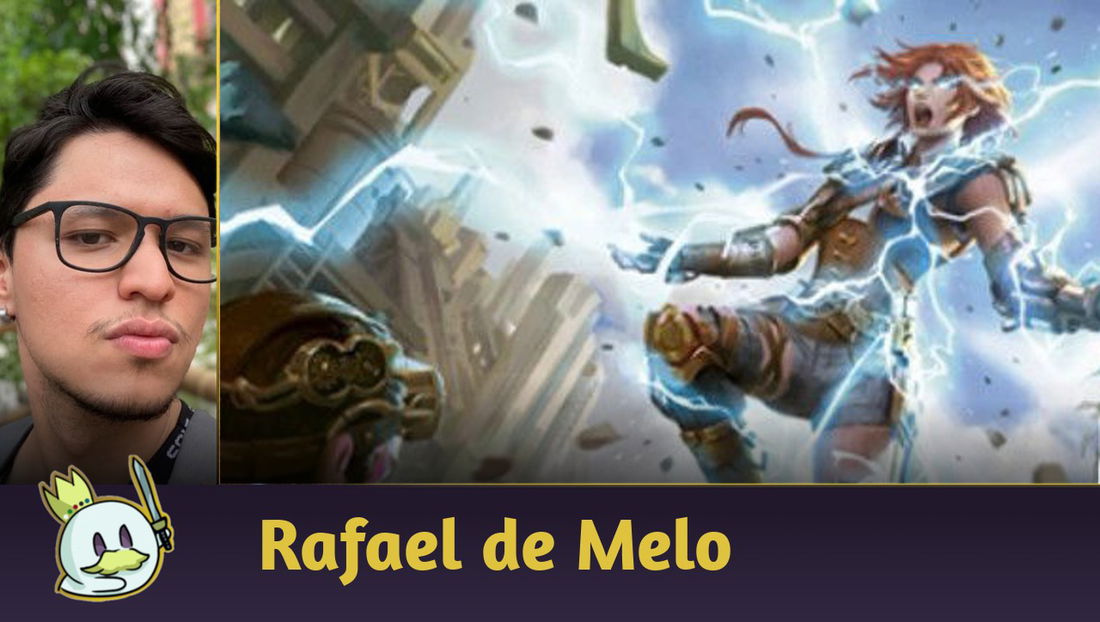Introduction
Almost a year and a half ago, Dusk Till Dawn was released and told us all about the war between Solana and Demonastery. It also introduced us to two new heroes: Prism, Awakener of Sol and Vynnset, Iron Maiden. However, both were the worst heroes in the meta at the time.
Vynnset's gameplay was clearly inconsistent and this Prism, unlike her Monarch version, couldn't do much without a decent weapon. At the time, her main weapon was Iris of Reality.
However, as time went on, they both got new cards and got a lot more competitive. For Prism, only one card was enough to take her from one of the worst heroes in the game to an entirely viable, competitive hero: Luminaris, Angel's Glow. Let's explore her and understand her dynamic, which is different from any other Flesh and Blood hero!
The Illusionist Class and Prism's Story

When she was valid in Classic Constructed, Prism, Sculptor of Arc Light was a nightmare to many decks. While aggro decks like Briar, Warden of Thorns didn't struggle against her, slower decks simply had no chance. Oldhim, Grandfather of Eternity, Bravo, Showstopper, and even Bravo, Star of the Show struggled to deal damage to Prism and deal with her many auras, which were like "Harmonized Kodachis" thanks to Luminaris. Furthermore, her set of defensive cards, like Soul Shield (2), and all her above-average attacks with go again made her one of the most polarized heroes in the game.
However, Prism hit Living Legend status in 2022 and took not only Luminaris, but also the entire Illusionist Light pool with her - therefore making Dromai, Ash Artist the only valid Illusionist behind. This was a well-beloved hero, and, like we mentioned, Dusk Till Dawn brought her back, albeit not as triumphant as before. Her life was significantly smaller, she didn't have access to go again, and had a terrible weapon (Luminaris, Celestial Fury), so she was one of the worst heroes in Classic Constructed.
Now, Heavy Hitters has come along and brought us a new weapon for this Illusionist: Luminaris, Angel's Glow, which put this deck on another level and made this hero truly competitive again.
The Deck
In this article, we'll review the deck that placed 2nd at the Calling: Lyon, as it is not that different from other Prism decks and has shown us it can perform really well.
The most important part of this deck is understanding Prism and the Figment mechanic, so we'll split this analysis into four parts: the hero and Figment, auras, attacks, and then all the other cards.
Prism and Figment

The first thing that you'll notice when you look at Prism is that she only has 32 life. Usually, heroes that have less life do "unfair" things, and she is no different.
Her ability includes two mechanics: the first one states that, whenever you put a Herald into your Soul (Souls are the cards under your hero), you can tutor a Figment and put it in play. Please note that you can use this ability more than once per turn.
But, after all, what is a Figment?

All Figments are the same: they're 4-cost instants that have Legendary (this means you can only play one copy of them in your deck), and, when they enter the board, something happens. Figment of Erudition (2), for instance, creates a Ponder. And they're also permanents, so they stay on the board. But that's not all.
Prism's second effect states that we can pay two resources, banish a card from Prism's Soul and awaken a Figment. This is how it all gets more interesting.

When you awaken a Figment, it turns into an ally Angel (just like Dromai's Dragons) with four life, ward 4, and an ability that costs 2 if you want to attack with it. Each one also does something when you attack with them. When you attack with Suraya, Archangel of Erudition and banish a card from Prism's Soul, for instance, you draw two cards. Each Figment can turn into an Angel, and, in this deck, we play a total of 7 Figments (out of the 8 available in the game).
Please note that, as they are allies, your opponent can attack your Angels instead of Prism, but, as they also have ward 4, you can destroy them to prevent damage. So, be careful if you want to protect them.
Attacks
However, to set all of this up, you'll need to put Herald attacks into Prism's Soul, so putting attacks like Phantasmaclasm (1) in there is useless. This deck plays many Herald attacks, in all of their colors, to make sure we can use Prism's ability at any moment.

Herald attacks are essential to make this deck work, so we'll only play these types of attacks and their effects.
Please note that you'll put all of them into your Soul pile when they deal damage to your opponent. This means you don't need to do anything except deal damage to your opponent to use your hero's ability and tutor a Figment. A few other cards included in this deck will help us do this; we'll discuss them later on.
While Wartune Herald (1) is the most efficient attack you can use (it costs one, blocks for three and has seven power), Herald of Protection (1) creates a Spectral Shield, which is quite useful to prevent a bit of damage. Herald of Triumph (1), in turn, cannot be destroyed by attacks with 6 or more power because of its Phantasm ability.

The other Herald attacks are less efficient, but can be useful in certain situations. Herald of Erudition (2) is the safest attack because it has Dominate and can draw you cards. Herald of Ravages (2) punishes opponents that don't have a solid protection against arcane damage, and Herald of Judgment (2) is the least relevant of all - it is only in this list because it is another attack.
Auras
An Illusionist deck isn't complete without its auras. Because Prism plays an older set of cards, she inherited some of the most inconvenient auras in the game, and, with them, one of the strongest mechanics in the game: Spectra.

Merciful Retribution (2) can win the game "out of nowhere" because it deals arcane damage whenever one of your attacks or auras is destroyed, but, in this deck, it is even more powerful. Because it also lets you put destroyed attack actions into your Soul (that is, the attack actions you'll destroy with Phantasm), you'll be able to tutor a Figment even if you can't deal any damage with Herald attacks. With this aura, you'll always be ahead, regardless of the situation.
Parable of Humility (2) is a lot more useful when your opponent plays many cards with six power or greater, like Guardians and Brutes. Your opponent will struggle to destroy Herald of Triumph (1) if you play these two cards together.
Arc Light Sentinel (2) is controversial, but is excellent with Prism. This specialization forces your opponent to attack it the next time they attack. This means they won't be able to attack your hero or any of your Angels before they destroy this Aura. And, as it has Spectra, their attack won't resolve and their turn will end immediately - even attacks with go again won't resolve, and they won't get their Action Point back. At the right time, this card can turn the game in your favor completely and make your opponent lose their turn entirely.

Genesis (2) is an important engine to this deck. As its effect happens before your Action Phase, it doesn't activate your hero's ability if you put a Herald attack into your Soul. However, its effect will feed your Soul and also create Spectral Shield, besides filter your hand as well. If this aura remains on the board for too long, Prism will be completely protected against any damage, and will also filter your hand every turn.

These two auras are still very useful in certain matches. Passing Mirage (3) works just like Parable of Humility (2), whereas Pierce Reality (3) is the complete opposite: it is extremely useful when your opponent isn't going to destroy your attacks. With this card, you'll deal more damage every turn.
Other Cards
Lastly, the other cards in this list will support this entire strategy.

These two instants play entirely different roles. Angelic Wrath (1) punishes opponents that block an attack with no margin for errors or unexpected situations (which is what aggro decks do). Celestial Reprimand (2), in turn, debuffs an attack that would destroy one of your attacks, and thus makes your opponent's block incredibly inefficient.

Soul Shield (2) might not activate your hero's ability, but it is great because it blocks a reasonable amount of damage, and thus protects your Angels. It also feeds your Soul, which will help you pay for the extra costs of many other abilities.

Lastly, these two cards are not necessarily essential for this deck, but they can improve some plays. Light of Sol may let you put a card into your Soul, and, if that card is a Herald, it will let you tutor a Figment. Great Library of Solana, on the other side, gives you Intellect 5, which, obviously, is incredibly powerful.
Equipment

Luminaris, Angel's Glow was the weapon that put Prism back under the competitive spotlight. This card grants a Herald and an Angel go again if you have a yellow card in your pitch zone, which is quite easy considering this deck basically only plays yellow cards. Some lists use Iris of Reality in the inventory to support a sort of hybrid game plan, but, as this is not the case, we won't explore this idea further.

Besides having Spellvoid 2 (which is very relevant against arcane damage), Halo of Illumination lets you cycle your hand (for instance, if you don't have any yellow cards or attacks), but you'll mainly use it to put a Herald into your Soul and tutor a Figment on your opponent's turn. This way, you'll be able to play more defensive Figments, like Figment of Protection (2) or Figment of Triumph (2).

Dream Weavers was the most standard option for Prism because it removes Phantasm from any attack at a critical point in the game. However, the new equipment, Calming Gesture, gave Prism more flexibility. It has Arcane Barrier and can also create a Spectral Shield, which can be very useful in certain moments.

Empyrean Rapture became Prism's standard equipment because it lets you activate her ability "for free", which, in turn, lets you awaken a Figment without spending any resources. However, Vestige of Sol still has space in slower matches.

Phantasmal Footsteps has been Prism's favorite equipment since her Monarch days. It not only returns your Action Point after one of your attacks is destroyed (which is critical in some matches) but also lets you pay a resource to block 1 with it until the end of the turn. This is very useful against opponents that constantly close the combat chain.
Tips and Matchups
Some important strategies with this deck are:
- A common turn with Prism is to attack with a Herald, attack with an Angel, and then finish with another Herald or an aura;
- Most of your auras are instants. Take advantage of that on turn 1 or whenever you can take hold of the game;
- Keep an eye on Luminaris, Angel's Glow's conditions. You'll need to have a yellow card in your pitch zone to give go again to your attacks;
- You'll need to tutor different Figments according to the game state, but the best ones in a vacuum are Figment of Protection and Figment of Erudition.
Matchups:
- Against decks that play many attacks with 6 power or greater, Celestial Reprimand (2), Parable of Humility (2), and Passing Mirage (3) are essential. With them, you'll protect your own attacks from being destroyed;
- Against aggro decks, abuse the fact Phantasm is not an issue and deal as much damage as you can with Pierce Reality (3) and Angelic Wrath (1);
- Your Angels have ward 4, Halo of Illumination has Spellvoid 2, and Dream Weavers has Spellvoid 1, so stopping a Kano, Dracai of Aether combo will not be an issue. Furthermore, ward is quite useful against any opponent that threatens a lot of damage, like Azalea, Ace in the Hole.
Final Words
Prism, Awakener of Sol is quite different from her original version. The fact you can both be more aggressive with your Heralds and play around your Angels gives her a lot of depth, and makes your choices harder. She might be difficult to face for some players, but she's much more balanced than her original version, as well as more versatile - for instance, you can build her in many ways.
What do you think of Prism? Tell us your thoughts in our comment section below.
Thank you for reading, and see you next time!














— Comentários 0
, Reações 1
Seja o primeiro a comentar